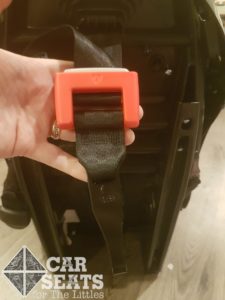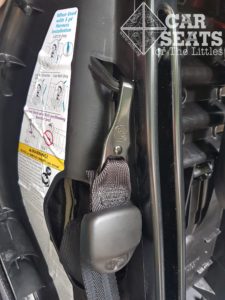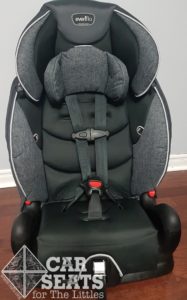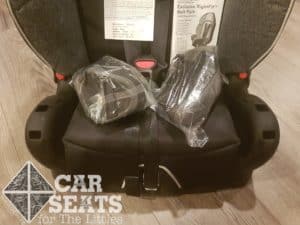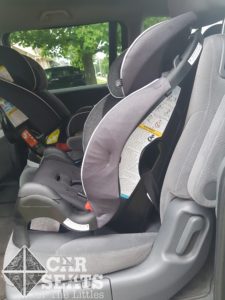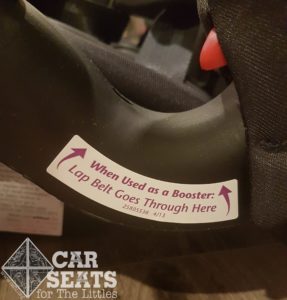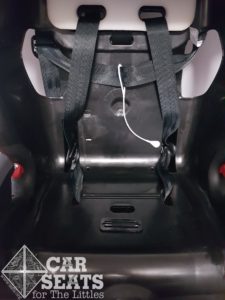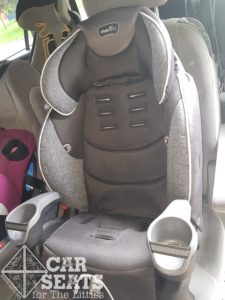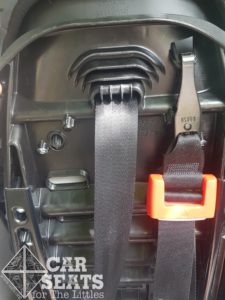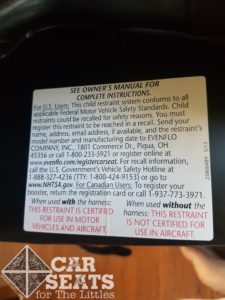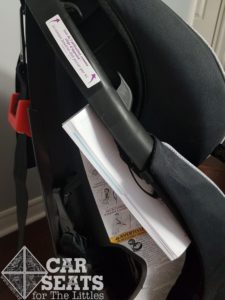The Evenflo Maestro is a workhorse of forward facing only combination car seats. It is lightweight, budget friendly, and is straightforward to install and to use. All of these things make the Maestro a terrific option for air travel. Let’s take a new, refreshed look at this seat that has become a staple in the world of car seats in both the United States and Canada.
CSFTL Quick Stats
- Forward facing weight range: 22-50 pounds
- Forward facing height range: 28-50 inches
- Forward facing age minimum: 2 years (Note: this was a change to the December 2016 manual. Maestros manufactured before/around that time may not have this stipulation. Always follow the manual that came with your car seat.)
- Booster weight range: 40-110 pounds
- Booster height range: 43.3-57 inches
- Booster age minimum: 4 years (CSFTL advocates that children be at least 5 years old before transitioning to a booster seat)
- Expiration: 6 years
- Lower anchor weight limit: 50 pounds
Measurements
- Highest harness height: 18 inches
- Booster belt guide height: 18 inches
- Crotch buckle slots: at 4.5 and 6.5 inches from the back of the seat pan. Outer slot must be used for children who weigh 40 pounds or more.
- Shell height: 26 inches
- Width at widest point (cup holders): 19 inches
- Width at widest point (with caps instead of cup holders): 18 inches at the back
- Seat weight: 10.5 pounds
Features
- RED top tether
- Two cupholders (cupholder caps can be ordered separately from Evenflo)
- Harness strap covers (on select models. For models that do not come with strap covers, they can be ordered separately from Evenflo)
- Harness holders
- Optional head pillow
Red Top Tether
The Maestro includes the new and improved red tether anchor casing from Evenflo, which improves visibility of this vital part of your child’s car seat. Anything that helps caregivers use a seat more easily and keep their children safer is a big plus!
Harness Holders
These handy pockets are a great place to store the buckle tongues while the car seat is not in use. This keeps them out of the way while loading the child and they can also keep the buckle tongues from getting too hot while the seat is unoccupied.
Lower Anchors (LUAS)
The Evenflo Maestro includes standard hook-on lower anchor connectors. Because the seat is so lightweight and accommodates children who weigh up to 50 pounds in harnessed mode, the lower anchors can be used for the full lifetime of the seat in harness mode.
The lower anchors are optional in booster mode. If the lower anchors are not used in booster mode, the Maestro must be buckled in with the vehicle seat belt when it’s unoccupied.
Cupholders/Caps
The Evenflo Maestro ships with two cupholders. These are required unless the caps are used in their place, but we have found that many caregivers don’t realize that they need to be installed. That error may be due to the instructions for installation being on page 37 of the manual. We feel that if the instructions were toward the beginning of the manual, it would be more obvious to caregivers that they are required despite the cupholders being featured in every image of the Maestro throughout the manual.
To install the cupholders, snap them on the seat until they lock in place. Turn the seat over and check that the locking tabs on each cupholder are securely locked in place.
Instead of cupholders, optional caps can be purchased and used in their place. The caps do not ship with the seat (with the exception of some program versions of the Maestro), so if you need them they will need to be ordered separately. Customers from the United States can order these caps online or by calling Evenflo’s ParentLink, while Canadian customers will need to call ParentLink. We’ve installed the cupholders first, then the caps so you can see how that looks. When the caps are in place, the seat is a bit narrower which can help in tight situations.
To uninstall the cupholders, push the locking tabs to the side and remove the cupholders. This sounds simple but can be quite challenging, as the cupholders lock into the seat with plastic tabs. Removing the cupholders required a team effort and is not something we would recommend doing regularly. The caps can be installed by snapping them on the seat.
Installation — Harness Mode
Vehicle Seat Belt
Installation with the vehicle seat belt is very easy. Loosely attach the top tether to the vehicle’s tether anchor. If the top tether does not reach the tether anchor in the vehicle, a tether extender can be purchased from Evenflo. Place the Maestro on the vehicle seat.
Route the vehicle seat belt through the belt path (which is nice and open, so you can easily reach through the seat to feed the belt through), buckle the seat belt, engage the locking mechanism, and tighten the vehicle seat belt until the Maestro moves less than 1 inch at the belt path. Tighten the top tether and the seat is installed.
Lower Anchors (LUAS)
Installation with the Maestro’s lower anchors is also very straightforward. Loosely attach the top tether to the vehicle’s tether anchor. If the top tether does not reach the tether anchor in the vehicle, a tether extender can be purchased from Evenflo. Place the Maestro on the vehicle seat.
Unclip the lower anchor connectors from their storage locations at the sides of the seat, and attach to the vehicle’s lower anchors. Remove the part of the Maestro’s cover that’s over the belt path to expose the belt path, then pull on the lower anchor webbing from inside the belt path to tighten the lower anchors until the Maestro moves less than 1 inch at the belt path. Tighten the top tether and the seat is installed.
Fit to Child — Harness Mode
3 Years Old
Our first model is 3 years old, 39.5 inches tall, and weighs 34 pounds. She normally rides rear facing, but is close to maxing out the rear facing height limit on many car seats. At 3 years old, riding forward facing is a safe option for her.
She was very excited to try out this new car seat, and found it quite comfortable. She defaulted to riding “criss cross applesauce” and seemed happy that the Maestro was able to accommodate that habit.
5 Years Old
This 5 year old is 44 inches tall, and weighs 46 pounds. He also found the Maestro to be comfortable, and the seat fit him well. With the harness in the highest position, he has about a year of torso growth left in harness mode, and would likely hit the 50 pound weight maximum before outgrowing the seat by height.
5 Years Old
Our next 5 year old model is 48 inches tall, and weighs 47 pounds. She is quite tall for her age, but is still able to fit the Maestro in harness mode, though not for long.
She’ll likely outgrow this seat after her next growth spurt. At that point, the top harness position will likely be below her shoulders, making the seat outgrown in harness mode. She found the Maestro very comfortable and was able to buckle herself into the seat – that was an added bonus.
Her favourite feature? The elastic cup holders. She squealed when she saw them and immediately shoved her hands through them every time she buckles in. We just chuckle and let her be herself! You be you, kiddo.
Converting from Harness to Booster Mode
In the instruction manual, Evenflo stresses that to use the Maestro in booster mode, the shoulder belt MUST be routed properly, the shoulder belt MUST cross midway between child’s shoulder and neck, and the lap belt is low and snug across the child’s hips.
Converting from harness to booster mode is very straightforward: Loosen the harness, remove the harness from the slots on the seat, remove the seat cover, and reattach the harness to the splitter plate. Tuck the chest clip and buckle tongues in the recesses at either side of the seat shell.
Remove the crotch buckle and reattach it upside down under the seat (so it is still attached to the seat but does not affect the child’s fit). Reattach the cover, and the Maestro is now in booster mode.
Top Tether Storage (Booster Mode ONLY – ALWAYS Use the Top Tether Forward Facing)
The top tether stores on a labelled plastic clip on the back of the shell of the Maestro. We love that Evenflo has moved to a red tether for visibility, since it is such an important safety feature that’s legally required in Canada for forward facing harnessed car seats! The tether may be used in booster mode but is not required.
Fit to Child — Booster Mode
5 Years Old
Our first booster model remains 5 years old, 44 inches tall and 46 pounds. He normally rides in a harnessed car seat, but agreed to model the Maestro in booster mode for us while the vehicle was parked.
The Maestro fit him very well in booster mode. The lap belt is low on his hips, and the shoulder belt, when routed through the headrest belt guide, is centered on his shoulder.
5 Years Old
Our second 5 year old model also has the same stats as above: she is 48 inches tall and 47 pounds. She is on the verge of outgrowing the Maestro in harness mode due to her torso height, and she has the same issue in booster mode in the Maestro since the headrest doesn’t adjust. While the shoulder belt *just* fits her with the belt routed through the headrest, it won’t fit for long.
For seats made after March 2014 Evenflo allows the shoulder belt to be routed over the headrest for children in this predicament. Since there are still some versions of the Maestro that do not allow this routing, we always recommend following the manual that came with your seat.

Evenflo Maestro booster mode – 5 years old, 48 inches and 47 pounds – alternate shoulder belt routing
We tried that alternate shoulder belt routing and unfortunately did not find that it provided her with an acceptable shoulder belt fit.

Evenflo Maestro booster mode – 5 years old, 48 inches and 47 pounds – alternate shoulder belt routing
Routing over the headrest created a large gap between the shoulder belt and her shoulder, which makes this not a safe option for her. It seems that when she outgrows the harness she would need to look at either a longer lasting harnessed car seat or a dedicated booster.
7 Years Old

Evenflo Maestro booster mode – 7 years old, 51 inches and 67 pounds – alternate shoulder belt routing
Our 7 year old model is 51 inches tall and weighs 67 pounds. He is under the height, weight, and fit requirements of the Maestro. In booster mode, the child’s ears must be at or below the top of the Maestro’s headrest – our model JUST fits within this requirement.

Evenflo Maestro booster mode – 7 years old, 51 inches and 67 pounds – alternate shoulder belt routing
We needed to route the shoulder belt over the headrest for this model and the fit was borderline acceptable. The shoulder belt JUST touched his shoulder, but it had a tendency to move along the headrest and slip off his shoulder if he moved at all in the seat because there is no guide on the headrest to hold the belt in place. This might be an acceptable option in an emergency, but isn’t something we would want to use on a daily basis.
Important Information — Where to Find
Date of Manufacture and Expiration: The Maestro expires 6 years after the date of manufacture. This information is located on a sticker on the back of the seat’s shell.
The National Safety Mark (Canada): This label is located on the back of the seat’s shell with the date of manufacture label
Airplane Use Approval Label (United States): The red writing on the label on the side of the seat indicates that the Maestro is approved for airline use in harness mode.
Airplane Use Approval Label (Canada): The Canadian version of the Evenflo Maestro is certified for use in both Canada and the United States. The same sticker that indicates the Maestro is approved for use on an airplane also indicates that the seat meets both CMVSS and FMVSS.
Manual Storage: the instruction manual stores in a slot on the back of either side of the seat’s shell
Overall Thoughts:
While there are car seats that harness longer by height and by weight, most kids don’t end up needing those high height and weight limits. For the majority of children, the Maestro would be an excellent option as either a spare, travel, or primary car seat. It may not have extra bells or whistles, but it is an easy seat to use, and all of our models found it comfortable. While not every child can use it in booster mode, at the price point it makes a great option even if families only use it for the harness capability for a child from 2 until around 5-6 years old.
Giveaway! United States and Canada!
Evenflo is generously giving away a total of two Maestros — one for a reader in the United States and one for a reader in Canada. Please read our terms and conditions, then enter below for your chance to win!
a Rafflecopter giveaway


